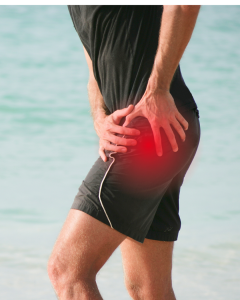 Hip pain is a common complaint we encounter daily in the clinic, often multiple times a day.
Hip pain is a common complaint we encounter daily in the clinic, often multiple times a day.
The two primary causes of hip pain are either joint pain or musculotendon pain. While pain
presentations can vary widely, here are the two most frequent patterns:
- Back or side of the hip pain is often linked to muscular or tendon issues, such as gluteal
pain (your “butt muscle”) or piriformis syndrome. - Groin pain, on the other hand, is more likely tied to hip joint issues.
This blog post will focus on glute pain. If you’re experiencing groin pain, check out Part 2 of this
series!
Understanding Lateral Hip Pain
The general term for lateral hip pain is greater trochanteric pain syndrome (GTPS). This
umbrella term includes conditions like gluteal tendinopathy, hip bursitis, and IT band pain. Even
with advanced imaging like MRIs, pinpointing the exact source of pain can be challenging
because it often stems from multiple structures simultaneously.
Another potential cause of hip pain is piriformis syndrome. True piriformis syndrome occurs
when the piriformis muscle presses on the sciatic nerve, causing hip pain and pain radiating
down the back of the leg. However, current findings suggest that this scenario is relatively rare.
More often, the pain is due to an irritated nerve in the low back, which leads to irritation in the
hip musculature and leg pain.
Common triggers for GTPS and piriformis syndrome include:
- Standing on the affected leg.
- Going up or down stairs.
- Sitting on hard surfaces.
- Crossing the legs.
- Lying on the affected side.
These activities place stress on the lateral hip’s muscles or bursa. The pain usually develops gradually from overuse, poor mechanics, or doing too much too soon. Although it’s less common, acute injuries, such as falling on the hip or sudden cutting or turning movements, can cause a strain in the area.
How Do We Address Greater Trochanteric Pain?
The first step is identifying why the pain is occurring. If there’s a specific injury event, such as a
fall or sports incident, the cause is straightforward. Acute injuries often heal with activity
modification and time. It’s best to consult a medical professional, such as a physical therapist,
athletic trainer, or physician, to rule out serious injuries. They’ll guide you on suitable exercises
and activity limitations as you recover.
For pain that has persisted for weeks, months, or even years, the root cause may not be
localized to the hip. This is where the concept of regional interdependence comes in—issues
elsewhere in the body, like core stability or endurance deficits, may be overloading the hip.
For example, if your core or hip muscles can’t adequately stabilize the hip during activities like
walking, stair climbing, or jumping, the hip muscles may be overstrained. Repeated stress on
the greater trochanter will eventually cause tissue breakdown and pain.
What’s the next step?
Your physical therapist will perform a thorough assessment of muscle strength, flexibility, and
stability. Based on the findings, you’ll collaborate on an exercise plan tailored to your goals,
along with activity modifications to allow your hip to recover while keeping you as active as
possible.